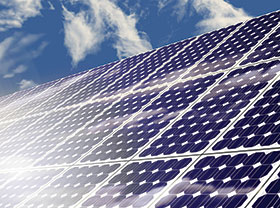Reliable, affordable energy storage – the key to unlocking the renewables drive
16 May 2018
Power Electronics / Power Management

The power purchase agreements (PPAs) signed recently by state-owned power utility Eskom, ended three years of waiting and uncertainty, and represent a significant step towards a truly sustainable energy vision for South Africa and Africa as a whole. This will enable R56 billion of new investment in the economy over the next two to three years, which will immediately contribute to significant growth in the economy and job creation. According to the Department of Energy, the 27 projects are expected to create 58 419 full-time equivalent jobs for South African citizens, mostly during the construction period.
In the realm of telecommunications, opportunities also exist for data centres to make greater use of renewable energy sources. However, renewable energy sources, such as wind and solar, have variable outputs at times when there is a lack of wind or sun, thus requiring the use of battery rooms where excess energy can be stored for later use.
Forbatt batteries have been at the forefront of developing longer-lasting, more efficient and reliable batteries, which the company sees as an essential aspect of the age of renewable energy. Most renewable sources of energy rely on sources that can come and go and so it is crucial that we can harvest this energy when it is available and then store it for later use, efficiently and reliably. While much of the green movement revolves around harvesting renewable energy, businesses are heavily investing in the means to store this energy.
The most common battery types used for storing energy generated from renewable energy sources are lead-acid batteries. Although new options are being developed all over the world, sealed lead-acid batteries remain a very viable storage alternative. Valve regulated lead acid (VRLA) batteries are very widely used for energy storage in data centres because of their high power density and ease of installation.
Because of the design of VRLA batteries, they are considered to be sealed as they do not allow for the addition or loss of liquid. VRLA batteries make use of safety valves that release pressure when internal gas builds up, which can then be recombined. Its design also allows for flexibility in its location within a data centre.
With a well-planned and thoroughly integrated renewable energy storage solution for data centres, the facility will have power on demand always, and especially during those mission-critical phases or processes.
For more information contact Russell Ruiters, Rull Technologies, +27 (0)21 905 0095, [email protected], www.rulltechnologies.co.za
Further reading:
ABB’s Mission to Zero drives South Africa’s energy transition
ABB Electrification Products
Power Electronics / Power Management
ABB Electrification is charting a bold path towards a net-zero future with its Mission to Zero programme, a blueprint that combines energy efficiency, electrification, and digital innovation to accelerate the transition to clean energy.
Read more...
Energy harvesting using a battery-less IoT system
NuVision Electronics
Editor's Choice Power Electronics / Power Management
Energy Harvesting plays an essential role in the foundation of ambient IoT, a new generation of ultra-low power connected devices that operate by drawing energy from their environment instead of relying on traditional batteries.
Read more...
Driving power, defining performance
Future Electronics
Power Electronics / Power Management
Vishay’s portfolio of inductors, current sense resistors, and MOSFETs provides a comprehensive solution for intelligent power management.
Read more...
Battery simulator module simplifies BMS testing
Test Dynamics
Power Electronics / Power Management
The PXI/PXIe solution from Pickering Interfaces offers a scalable, modular design for faster development cycles, lower total cost of ownership, and improved safety.
Read more...
DC PSU: The cornerstone for efficient solar-storage systems
Vepac Electronics
Power Electronics / Power Management
PV energy storage systems are evolving and DC power supplies, with their technical characteristics that are naturally compatible with new energy, have become a key carrier for improving system energy efficiency.
Read more...
Why local manufacturing, maintenance and support are key to the success of South Africa’s energy future
Power Electronics / Power Management
Although new renewable generation capacity is being developed, the current transmission infrastructure may not fully support the connection of these sources to the national grid or adequately deliver power to areas of high demand.
Read more...
Converter power modules for 48 V networks
Altron Arrow
Power Electronics / Power Management
The economic and quality-of-life benefits of electrification is driving the adoption of HV to 48 V DC-DC conversion across many markets with 48 V power modules becoming more common.
Read more...
The importance of power integrity
Spectrum Concepts
Power Electronics / Power Management
[Sponsored] Behind every high-speed system lies the need for power integrity. Without it, even the cleanest signal paths become compromised.
Read more...
Precise multi-vital sign monitoring
Future Electronics
Power Electronics / Power Management
The AS7058 by ams OSRAM is an integrated multi-vital sign monitoring device, which provides a complete photoplethysmogram, electrocardiogram, body impedance sensor, and electrodermal activity sensor.
Read more...
Automotive battery diagnostics tester
Comtest
Power Electronics / Power Management
Midtronics’ MVT handheld battery tester is a revolutionary tool, powered by MDX-AI, which is set to redefine the standards of battery diagnostics and testing in the automotive industry.
Read more...



